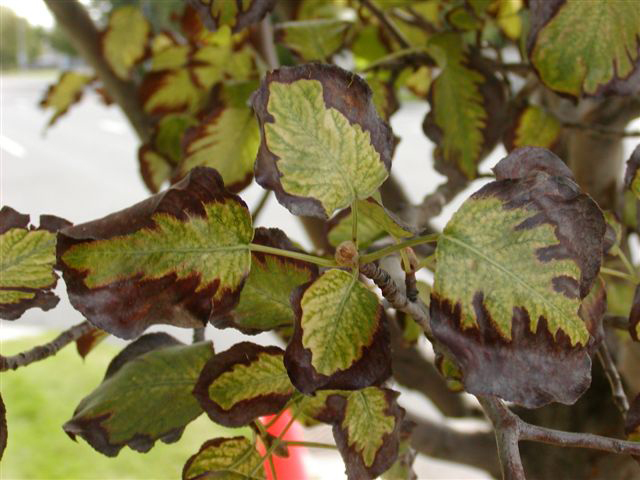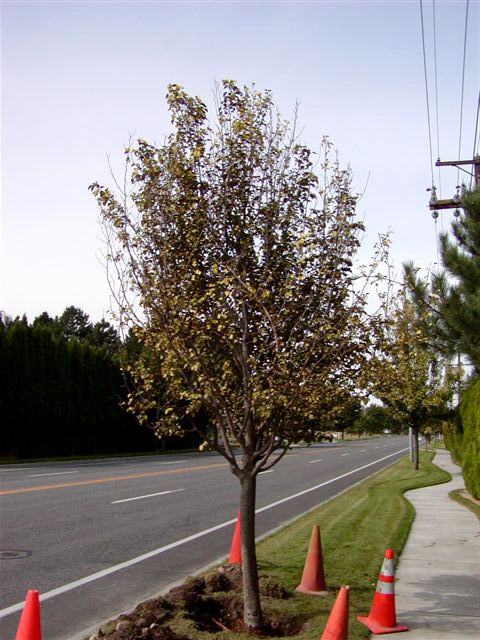I haven’t finished with the water droplets story yet – but I just had to add some more evidence to the tree planting discussion from last week.
Consider this series of photos below. This is a street tree in Kennewick, WA (in the southeastern part of the state, where summers can be intensely hot and dry). Every spring, this tree leafs out just fine – and every summer the leaves suffer marginal and tip scorch. This is a classic symptom of chronic drought:

As an amenity, the tree fails. Even though the landscape is well-watered, as shown by the healthy turf in the next photo, the canopy is sparse and dry.

An excavation of the roots explains why: the tree was planted too deeply and has developed a secondary set of roots:

Note how sparse these roots are – which is typical of many adventitious root systems. While the roots are adequate for water uptake during the cool spring weather, the hot dry summers suck away more water from the leaves than this puny root system can absorb, even when well-watered.
My point: sure, trees might survive being planted too deeply. But thrive? Not in this case – and this is a well-managed landscape! With less care this tree would have died long ago. The only solution here would be to replace this tree – correctly.
Looking at the planting situation I can’t help but wonder how the tree would do even if it had been planted perfectly — a road on one side and a sidewalk on the other is not the best situation.
Welcome to the world of Washington State street trees! This is pretty typical of many urban areas – very narrow planting strips and always trees. Some trees do very well, and others don’t.
don’t forget that at some time in the future that the top right of the tree will be pruned off to keep it away from the overhead utility lines.
I think (though I am not positive) that this was a cultivar chosen for short stature. Street trees don’t tend to get very tall in this part of the state, though on my side of the mountains it would probably be twice as tall!
At our landscape company I have noted that Hispanic labor will often “dig to China”, and in the the heavy clay soil we have in Virginia this spells the inevitable doom of the tree, usually sooner than later. Our American born employees don’t dig any more than they are required to, but there’s a different group of professors to address that issue.
Is there a set of ‘regular’ roots below the adventitious roots that would support the tree?
Kenny, the original roots would be long dead by now since they were planted too deeply. That’s why the tree responded by growing a new root system from the trunk. As we’ve been discussing on Jeff’s earlier post (Being Wrong), some plants can successfully grow a new, fully functional set of roots, but others – like this tree – can’t.
So it’s not just that the tree was planted to deep and developed adventitious roots,it’t that tree was planted to deep, developed adventitious roots, and the original roots died.
Well, it’s both. The tree was planted too deeply for its roots to survive for long (too little oxygen), so it responded by sending out new roots closer to the soil surface. As those roots grew, the original roots died.
We have about sixteen amelanchiers (we had an additional eighteen that were removed) with very similar symptoms as your street tree. They have chlorosis and marginal necrosis in the late summer, although the chlorosis is not as distinctly interveinal and the necrosis pattern is more varied than your sample. A soil test suggests the problem is a manganese deficiency. Our trees could have been planted too deeply, but it seems unlikely every one would have the identical symptoms to the identical degree. What do you think? I also saw the same symptoms in the nursery where we acquired them. What about graft incompatibility? They are all the same cultivar.